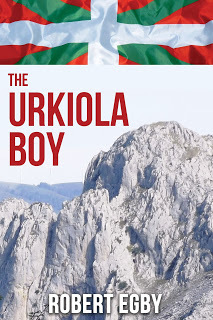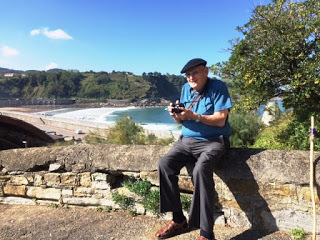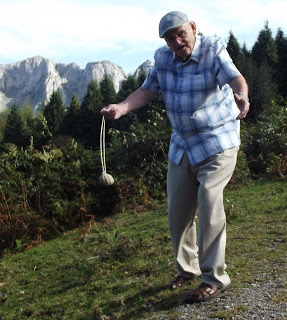CREATING THE URKIOLA BOY
THE AUTHOR TALKS ON CREATING "THE URKIOLA BOY"By historical novelist Robert Egby
Writing fiction is being creative but writing historical fiction is like playing God. The author is rearranging history, endangering past lives and creating doubts in the young minds of students. So I must apologize for THE URKIOLA BOY. (published June 2019)

Ever since the forerunner FOR THE LOVE OF ROSE was published in June 2014, I had Mikel Ybarra on my mind. Frank Barbury, the young American dairy farmer with his American-Basque sweetheart had braved the horrors of the Spanish Civil War at Elgeta and Durango in the heart of Euskal Herria – the Basque Nation.
In the creation of Rose and Mikel I amassed a collection of over two dozen books – ranging from Paul Preston’s magnificent 1,000 page biography, “Franco” through to Adrian Bell’s and Natalia In addition, over a good four years, my partner Betty Lou and I spent various times totaling three months in the Basque Country, asking questions, listening and taking photographs. Add to this the necessity to learn Spanish and converse in that language. Basque? It is as difficult as its origins are obscure.
Indeed the entire ancient Basque history is cloudy, hidden in the dusts of time. The more I studied them the more I was drawn to the Sumerians, Babylon and the stories on the clay tablets that are tucked away in the museums of at least six countries. And so a hero for the book was created.
Mikel was Basque and born to carry the birthmark of the ancients, notably Jubal. He possessed unusual gifts and talents so why was his teenage body, almost lifeless, washed up on an English seashore in 1938 when the Spanish war was at its peak.
It was necessary to have a storyline that moves along and yet reveals the life and struggle of the Basque people without too much heavy data. It’s a story that appeals to most people who enjoy historical fiction, particularly if you know Northern Spain, the Basques and England.
I needed to create a word picture of the Basques, their cultures, their survival under the Franco occupation, how they were treated and how they rebelled. In addition to the facts, I felt I needed to write about the strange and mystical origins of the Basques and how the ancestors would have shared their knowledge if they were alive during the period of the novel – 1937 to 1943.
It is important to understand that in spite of the warrior or gudari image that some Basques like to project and promote, there is another latent image that remains hidden in their culture.
Mikel Ybarra – the hero has various names -- together with his love Uda, is the symbol of that latent image. It’s in their psyche, their blood, their DNAs, their culture. They are born healers. They have the gifts, but the problem exists will they survive the meaningless glitter and attractiveness of the technology age and artificial intelligence?
About the book: The “bad man” of the novel is Captain Alejandro Aquino, born in La Coruña 1888, he is the fictional boyhood friend of the real life Lisardo Doval Bravo. He shadows the life of Doval and is his key henchman for ruthless killing.
Another real life “bad man” portrayed in the novel is Spanish Dictator Francesco Franco who triggered the Spanish Civil War in 1936 and ruled Spain and occupied the Basque Country until his death in 1975. By some strange thread dating back to 1920 Franco has the Urkiola Boy as his target from the Introduction to almost the last page where he orders the killing of his own Nationalist soldiers. Fiction? Far from it, Franco was renowned for killing his own people.
In essence the novel follows the life of a teenage Basque boy found on an English seashore – Selsey Bill, in fact. One of my favorite boyhood places. Suffering amnesia, British Intelligence gets him to relive his life and events – the bombing of Durango, the battle at Elgeta – and in the process discovers he has uncanny gifts. One is the ancient art of sling shot, another his uncanny ability with an ordinary rifle without a scope.
Mikel desperately seeks to return to Spain, but he’s young and inexperienced. British Intelligence trains him with various forces into being a commando or gudari as the Basques say. His mission: assassinate General Franco. Well, Mikel has his own agenda and it is hidden away in the Urkiola Range of Mountains near Durango. Armed with a group of more than two dozen men and women they launch raids from this base hidden in a mountain.
Over the days, weeks and months, Mikel trains his group in the deadly art of sling and other defense activities. All the time he thinks of Uda, a girl he met and adored in his teens and also his young teenage sister Zoriona. Both are held captive by Franco forces.
If you read my first book “For the Love of Rose” that told of the bombing of Durango, Frank and Rose see this little girl on the steps playing with a doll and it’s then they talk of having a family after the war. Later, Frank sees the apparently lifeless body of the little girl and wants to help but he is carrying the injured Rose. Well, the little girl is Mikel’s sister and that is where the connection with “For the Love of Rose” exists. Zoriona is now a young teenager held captive in the famous Les Cort Women’s Prison in Barcelona.
In the first part of “The Urkiola Boy” during Mikel’s training and development he is in England which played an important role in the Spanish Civil War. Thousands of Basque children were evacuated to various countries. Four-thousand came to Britain and were housed on estates which they called “colonies.”
An historian friend living in Maidenhead / Cookham in Berkshire emailed to say: “You know there was a colony at Bray Court,” and included a photo. It was stunning. I had spent the first 18 years of my life living in Maidenhead and had never heard of the Colony at Bray. It now plays a role in the novel. In fact, that’s one of the things I enjoy in writing historical novels, using real life places for the action.
 The author Mont de San Anton at Getaria. (Photo: Betty Lou)All the locations described in the book such as the bridge at Hendaye, the overlook point at
The author Mont de San Anton at Getaria. (Photo: Betty Lou)All the locations described in the book such as the bridge at Hendaye, the overlook point at Mont de San Anton at Getaria, the police station at Zumaia, the square at Elgeta, the battleground, they are all real places experienced by the author. The only place the author missed seeing was the Les Cort Mansion in Barcelona, which became an infamous prison during and after the civil war and later was reduced to rubble. It is now a shopping centre.
The plot calls for the hero Mikel to use an ancient weapon popular with the Sumerians and other soldiers in Babylon thousands of years ago. It was the sling shot, not a catapult but a simple sling with a pocket to hold a stone or a small rock. David used one on Goliath and the weapon is mentioned several times in the Old Testament. Well, I am a great believer that if one is going to write about an activity, you had better get the feel of flying stones from a sling shot. It took a lot of practice but finally I could hit a tree at 30 yards and that experience enabled me to write parts of the novel. Yes, while visiting the Urkiolas I actually practiced with the sling. My partner Betty Lou recorded the event by taking some photographs with the mountains in the background. Here's one.
 The author gaining experience with the ancient sling in the Urkiolas..
The author gaining experience with the ancient sling in the Urkiolas..(Photo Betty Lou Kishler)
The historical novelist must strive for accuracy. A Basque reader who checked various phrases in the novel noted that several of the characters have names that are no longer fashionable. “That’s good,” was my reply. “I gathered first names from sources that were important for the period of the book – 1936 to 1943. Actual names must reflect the age of life in a novel, I said.
One important part of the action in the novel is that the Basque flag flies on the top of the mountain. It was impossible for me to acquire a photo from the site so I devised another plan. I had many pictures of the mountains for a cover but I needed the flag – known as the ikurriña. Amazon delivered a five by four feet bandera (flag) and I tried photographing it. Blah. The manufacturer’s folds showed clearly. Betty Lou soaked it gently, then when it was dry used a steam iron to flatten it. Still, the flag looked blah. I needed a moving flag.
It is not the easiest task to get someone with a mast to fly the flag of a foreign country, so I stayed home and one morning when the sun was shining from a soft hazy sky with a gentle breeze blowing, I placed the flag on the lawn which needed mowing. The grass was tall enough to let breezes moved the flag. Sometimes too much. Others just right. For my cover photo I needed the area round the cross. Two dozen photos were taken and each one scrutinized. One appeared just right – a flag with frozen movement.
That is the shot that appears on the cover – above the Urkiolas! The folks at Jera Publishing, put the finishing touches with a big red title. It looked great. I have a 24 inch blowup of the cover on my wall. But that is how the cover came about.
When you read the novel, you’ll see what I mean about the Basque flag flying on top of the Urkiolas. It must make Dictator Franco mad -- wherever he is in the Spirit World.
The book is dedicated “to all the loved ones who lost their lives because of the Spanish Civil War ad to all those who waited in vain for their gudaris to come home.”
The Urkiola Boy: An Adventure in Basque Time is available at these bookshops.
Amazon and Kindle U.S.
The Book Depository -- Mailing Free to the World
Amazon and Kindle UK
Published on July 31, 2019 10:04
No comments have been added yet.



